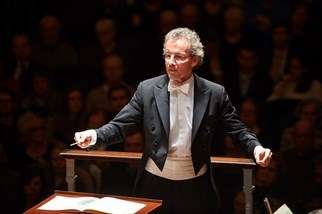|
Back
Goodbye to All That New York
Stern Auditorium, Carnegie Hall
01/23/2018 - & January 11, 12, 13, 2018 (Cleveland)
Johannes Maria Staud: Stromab
Gustav Mahler: Symphony No. 9
Cleveland Orchestra, Franz Welser-Möst (conductor)

F. Welser-Möst (© Roger Mastroianni)
"...the music faded into the silence of eternity...
the last sleep which is our inalienable birthright."
Pitts Sanborn, New York World-Telegram, November 19, 1931
I have quoted this above phrasing many times over the years, as it perfectly expresses the magical effect of the last measures of Mahler’s Symphony No. 9 (Sanborn was a treasure-trove of musical thought), but never have I felt such a kinship for this little snippet of newspaper wisdom as today, after hearing this extraordinary performance by the Cleveland Orchestra at Carnegie Hall.
Mahler knew that he was dying and became resigned to the notion that the 9th would be his last orchestral effort. He even goes so far as to begin this four-movement farewell to the world with the hesitant rhythms of his own defective heartbeat (there is some controversy about this). Now totally in the grip of the past, he looks back to the opus ultima of his composition advisor, Anton Bruckner, and recreates the architecture of that composer’s own ninth symphony, framing, as did his predecessor, the short uptempo material between two gigantic slow movements which express the essential spirituality of each composer’s entire output. The first movement (Andante comodo) abandons sonata form completely, opting instead for a set of unequal variations whose variety of phrase lengths suggests the death of form itself.
When he thought that he was dying in the 1940’s, Mahler’s protégé Arnold Schoenberg wrote a piece (the String Trio) describing his stay in hospital which experiments with a total abandonment of form, using only isolated phrases to express the remaining loose threads of his own existence. Undoubtedly he was inspired in his equation of formlessness to death by this episodic first movement written by his mentor. In the Mahler, incidents from the composer’s life enter as snippets of string motives or abbreviated brass fanfares. Memories appear but only fleetingly. The flute plays a figure reminiscent of its embodiment of the human soul in the "Resurrection". The harp enters late in the movement and combines with the strings to produce the feeling of the great Adagietto from Mahler’s 5th As the movement ends the instrumental lines become thin, sometimes with only solo instruments playing. One is aware for the first time of the silence which surrounds this profound essay.
A forensic analysis of the performance is hardly sufficient to express its grandeur, but here are a few highlights: the first movement was anchored by a nonet of string bases who played with their resin on their sleeves. The profundity of the instrumental ensemble as a whole was astounding, the fluctuations from one mood to another, one tempo to another, were seamless and the ensemble sound was magical.
Movement 2 was the best, suitably raucous and “from the streets”. The bone-chilling ending was reminiscent of the conclusion of Mahler’s movement three from the Symphony No. 1. The Rondo-Burleske was simply great, shockingly so. And the conclusion, well, see Mr. Sanborn above. This was the performance of the season from a conductor who has not been in my good graces for a long time, in fact ever.
One should always attempt a positive note, so to Mr. Staud, who wrote the first piece on the program should not despair. I understand that the American television program The X Files is back in business after a multiple year hiatus. Perhaps they might want to commission something grisly from him going forward.
So in the same week we heard Mahler’s first completed symphony and his last. Amazingly, each of the nonet was well ahead of its time, loved but also hated by many. I am of the generation that matured during the explosion of interest in this great composer. It is one of my most cherished memories and I am most thankful for the experience.
Fred Kirshnit
|